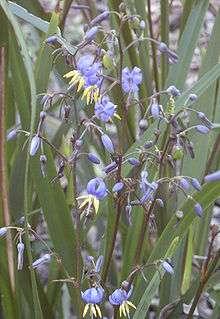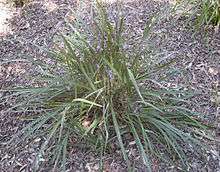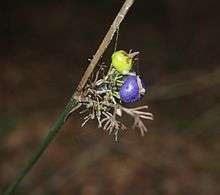Dianella caerulea
Dianella caerulea, commonly known as the blue flax-lily, blueberry lily,[2] or paroo lily,[3] is a perennial herb of the family Asphodelaceae, subfamily Hemerocallidoideae, found across the eastern states of Australia and Tasmania. It is a herbaceous strappy perennial plant to a metre high, with dark green blade-like leaves to 70 cm long. Blue flowers in spring and summer are followed by indigo-coloured berries. It adapts readily to cultivation and is commonly seen in Australian gardens and amenities plantings.
| Dianella caerulea | |
|---|---|
 | |
| At Mount Archer National Park, Queensland | |
| Scientific classification | |
| Kingdom: | Plantae |
| Clade: | Tracheophytes |
| Clade: | Angiosperms |
| Clade: | Monocots |
| Order: | Asparagales |
| Family: | Asphodelaceae |
| Subfamily: | Hemerocallidoideae |
| Genus: | Dianella |
| Species: | D. caerulea |
| Binomial name | |
| Dianella caerulea | |
Taxonomy
It was first described by English taxonomist John Sims in Curtis's Botanical Magazine in 1802. Its specific name is the Latin adjective caerulea "blue".[4] The genus name is derived from the Roman goddess Diana, with a diminutive suffix -ella.[3]
Dianella caerulea is highly variable species, with many forms found throughout eastern Australia.[3] Six varieties are known from the Sydney district alone.[5]
The species is described as having seven varieties, having been revised by Queensland botanist Rod Henderson in 1987 for the Flora of Australia:
- Dianella caerulea var. assera grows as a taller solitary tufted plant to 1.8 m high, and is found from Nowra north along the New South Wales coast and Blue Mountains into Queensland.[6]
- Dianella caerulea var. caerulea
- Dianella caerulea var. cinerascens is a pale-grey leaved form to 0.8 m inland and north of the Sydney basin, from Putty northwest to Wollar.[7]
- Dianella caerulea var. petasmatodes is a more mat-forming variant, which reaches 2 m in diameter and 1.3 m high. It is found on the far north coast of New South Wales into Queensland.[8]
- Dianella caerulea var. producta is a taller variety to 1.3 m found from Nowra and Blackheath north through New South Wales and into Queensland. It has a greenish white to blue perianth.[9]
- Dianella caerulea var. protensa is a smaller variant up to 0.5 m high, which grows as a solitary tuft. It is found from Nowra northwards through New South Wales into Queensland. It is found in sclerophyll forest on sandy soils.[10]
- Dianella caerulea var. vannata is a taller variant to 1.3 m recorded from the Blue Mountains, the far north coast of New South Wales and Queensland.[11]
Description


Dianella caerulea is a strappy herbaceous fruit bearing plant to about 1 metre (3 ft) high, with a thick spreading rhizome under the ground. The bright green leaves have straight or toothed margins, and may reach 75 cm (30 in) in length and 0.3-2.5 cm wide. The small (1-1.6 cm diameter) flowers bloom in spring and summer (August to January); the perianth is pale to a dark blue, or green-blue, and the anthers at the centre are yellowy brown. These are followed by small roughly spherical indigo-coloured berries which range from about 0.7 to 1.2 cm (0.3-0.5 in) in diameter.[12] These fruit are edible.
Distribution and habitat
The plant is distributed through a range in Victoria, New South Wales, Tasmania, and Queensland. It occurs in a wide range of habitats, from coastal heathland and even sand dunes.[3]
Cultivation
.jpg)
Believed to have been first propagated in England in 1783, Dianella caerulea is commonly cultivated in gardens, and is sometimes seen as a low-hedging plant in public spaces and amenities plantings. It is very hardy and long-lived, and suitable for rockeries.[3] It is tolerant of poor drainage and responds well to extra moisture. Plants attract fruit-eating birds and butterflies in garden settings.[13] The smaller denser forms in particular have potential for small gardens.[14]
Plant Hardiness
Dianella caerulea is a very hardy (snow and frost hardy) and long-lived plant once established. It can tolerate damp conditions but prefers moist well drained soil. It adapts readily to cultivation.[15]
References
- IPNI: Phormiaceae Dianella caerulea Sims Bot. Mag. 15: t. 505. 1801
- "Dianella caerulea". Australian Plant Name Index (APNI), IBIS database. Centre for Plant Biodiversity Research, Australian Government.
- Elliot, Rodger W; Jones, David L; Blake, Trevor (1984). Encyclopaedia of Australian Plants Suitable for Cultivation: Volume 3. Port Melbourne: Lothian Press. p. 259. ISBN 0-85091-167-2.
- Simpson DP (1979). Cassell's Latin Dictionary (5th ed.). London: Cassell Ltd. ISBN 0-304-52257-0.
- Fairley A, Moore P (2000). Native Plants of the Sydney District: An Identification Guide (2nd ed.). Kenthurst, NSW: Kangaroo Press. p. 361. ISBN 0-7318-1031-7.
- Wilson, K. L. "Dianella caerulea var. assera R.J.F.Hend". PlantNET - NSW Flora Online. Royal Botanic Gardens & Domain Trust, Sydney. Retrieved 2009-10-10.
- Wilson, K. L. "Dianella caerulea var. cinerascens R.J.F.Hend". PlantNET - NSW Flora Online. Royal Botanic Gardens & Domain Trust, Sydney. Retrieved 2009-10-10.
- Wilson, K. L. "Dianella caerulea var. petasmatodes R.J.F.Hend". PlantNET - NSW Flora Online. Royal Botanic Gardens & Domain Trust, Sydney. Retrieved 2009-10-10.
- Wilson, K. L. "Dianella caerulea var. producta R.J.F.Hend". PlantNET - NSW Flora Online. Royal Botanic Gardens & Domain Trust, Sydney. Retrieved 2009-10-10.
- Wilson, K. L. "Dianella caerulea var. protensa R.J.F.Hend". PlantNET - NSW Flora Online. Royal Botanic Gardens & Domain Trust, Sydney. Retrieved 2009-10-10.
- Wilson, K. L. "Dianella caerulea var. vannata R.J.F.Hend". PlantNET - NSW Flora Online. Royal Botanic Gardens & Domain Trust, Sydney. Retrieved 2009-10-10.
- Wilson, K. L. (1999). "Dianella caerulea Sims". PlantNET - New South Wales Flora Online. Royal Botanic Gardens & Domain Trust, Sydney. Retrieved 2009-10-09.
- Elliot, Rodger (1994). Attracting Wildlife to Your Garden. Port Melbourne, Victoria: Lothian. p. 39. ISBN 0-85091-628-3.
- Thompson, Paul (2002). Australian Planting Design. Port Melbourne, Victoria: Lothian. p. 144. ISBN 0-7344-0438-7.
- "Archived copy". Archived from the original on 2011-10-08. Retrieved 2010-11-13.CS1 maint: archived copy as title (link)
External links
| Wikimedia Commons has media related to Dianella caerulea. |
![]()